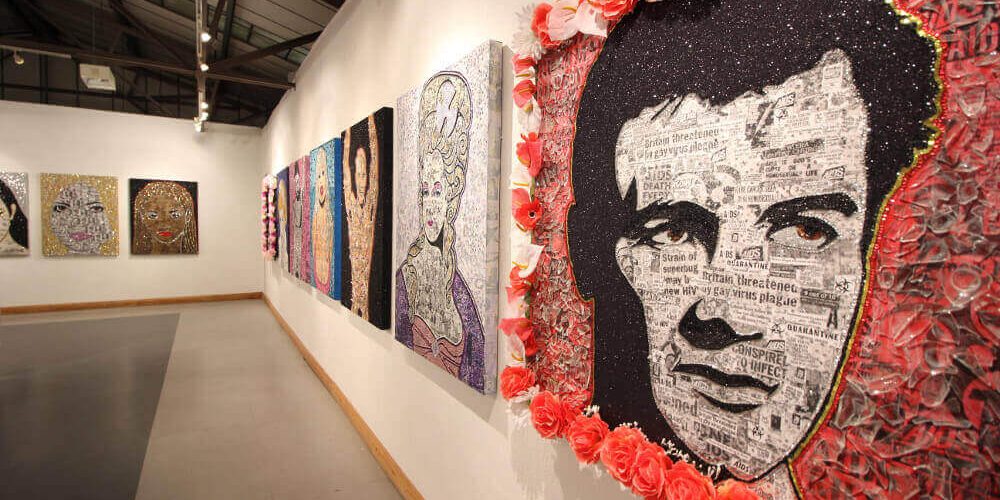Liverpool mixed-media artist Ben Youdan, in association with Liverpool Pride, unveils his most shocking art pieces to date at Baltic Triangle’s The Gallery. Curated by Duovision as part of their campaign for delivering consistent quality Liverpool art – the exhibition arrives just in time for ‘Tales from the City‘, Liverpool’s exhibition celebrating the last 50 years of the scouse LGBT+ community.
‘Glamour’ (displayed at The Gallery, Stanhope Street, 16th Dec 2017 – 14th Jan 2018) shows more than 30 of Ben Youdan’s works on this project and has been 2 years in the making.
It comprises of collages of anything from pornography, dimonte, broken glass, sequins, needles, etc., creating distorted versions of immediately recognisable faces. Faces such as Beyoncé and Donna Summer are shown side-by-side with the death-stare of Myra Hindley and the confused vacant expression on the mug-shot of Jon Venables (amongst others).
Challenging, disquieting and immediately complex, the brief was elegantly nailed down with Youdan’s assertion that in the media ‘Hindley was as much a ‘blonde bombshell’ as Marilyn Monroe’.
Ben explains:
“There are people who control what we see in the media: editors, producers, marketing companies, media moguls. In showing pictures and sharing stories, whether it’s of Kim Kardashian or Alan Kurdi (the 3-year old Syrian boy who drowned in 2015 in the Mediterranean whilst fleeing Turkey), there are undercurrents that have put that picture in front of you that have ulterior motives – marketing, sales figures, political interests.”
He points us towards his piece “Newsfeed” which is a depiction of both Kardashian and Kurdi.
“In our clamour for information and the media’s clamouring to be the source of that information, the Hindleys of the world often receive the same media treatment as a Kardashian.”
The question Ben may be asking is what has become of fame? What has become of Glamour? Who, if anybody, does that glamour belong to and where does that term “glamour” start and stop? We discussed this with Ben himself:
Is there a difference between fame, notoriety and glamour?
“There is, but we as an audience view stimulus in the same way. Tragedies like the Syrian boy and Princess Diana’s Car Crash have a uniting aspect and so does gossip and so does voyeurism. Public figures are either deified or vilified en-masse, but they very rarely remain as “people” in the public perception. For conspiracy theorists like David Icke, these people are sinister creatures, aliens, hellbent on slowly destroying mankind and for the ravenous and gossip hungry, these people are property and formerly human – but they are human. They all are.”

With Project Yewtree and the Weinstein scandal in Hollywood, the secret dark side of glamour is a hot topic for 2018. Was this an influence?
“It’s all slowly being brought into the light, isn’t it? Appropriate timing is what it is, though not entirely coincidental. The thing that surprised me about the abuse accusations in Hollywood is that people were surprised by it. Hollywood’s history is pockmarked with depravity from day one: ‘Fatty’ Arbuckle; JonBenét; rumours about the treatment of child actors Corey Haim and Corey Feldman; Peg Entwistle jumping off the Hollywoodland sign in 1932. People have been (at times literally) dying to get this into the open and I hope that reckoning is finally here. I have been examining this with my work for a long time.”
Why put this controversy through a Queer lense?
“There is an undercurrent of secrecy and otherness about it all and I have always had a fascination with things that seem one way at first, and then crumble under scrutiny.”
[At this point, we were looking at Youdan’s work ‘Tiny Tears’, which comprises of torn doll parts over a collage of high-profile sex-offenders. We moved over to ‘Illuminati Glitterati’, a collage of Illuminati and Masonic imagery forming the shape of Beyoncé’s face.]
“The rumour mill surrounding Beyoncé is a favourite of mine. Some people see her power, her influence and her willingness to use them as an indication of Illuminati involvement. I don’t agree with that, but I still enjoy the idea. I’ve always found something off about Beyoncé. She is beautiful, talented and intelligent but there is a mask there, I think. A living veneer, as if something behind her eyes has died.”
Is there a difference in your choice of model? Are some people in the paintings ‘targets’ rather than ‘subjects’?
“Is there a difference between those two things in the media? The bottom line for a News company is good viewing figures. This can be a Kendall Jenner exclusive, or it can be a large-scale human catastrophe.”
So is it “Us” vs. “Them”? Is the consumer blinded by corporate trickery into glamourising murder or sexual crime?
“Not exactly, no. The thirst for information is ingrained in human nature and those needs should be met in an uncensored and matter-of-fact way. But it is a true fact that while sex does sell, so does murder, controversy and crime – and it sells very well. I do not feel like the news-reading audience has a responsibility towards what information they consume, if they should consume or how they do so. Although at the same time, a person can’t lay all the responsibility on the media, because if the market for it didn’t exist, they would not be treating murderers like celebrities.”
Ben Youdan’s ‘Glamour’ Exhibition is running from the 16th Dec 2017 – 14th Jan 2018 at The Gallery, Stanhope Street, L8 5RE.
You can follow Ben Youdan’s work on Twitter, Facebook, Instagram, Tumblr and his official website.
Find out more about Liverpool Pride, here.
If you would like to see your work in Baltic Triangle’s The Gallery, contact curators and art heavy-weights Duovision via their website or Facebook.




